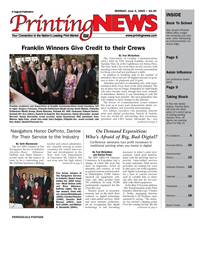|
  June 6, 2005, with Rachel Frank—The 2005 AIIM/On Demand Conference & Exposition had a change of venue this year, but drew an impressive crowd of attendees and vendors, as well as packed sessions and keynotes. In Philadelphia, 21,000 visitors checked out equipment, software, and other goodies from 350 exhibitors. In total, 35,000 professionals registered for the event this year. June 6, 2005, with Rachel Frank—The 2005 AIIM/On Demand Conference & Exposition had a change of venue this year, but drew an impressive crowd of attendees and vendors, as well as packed sessions and keynotes. In Philadelphia, 21,000 visitors checked out equipment, software, and other goodies from 350 exhibitors. In total, 35,000 professionals registered for the event this year.
Themes heard at keynotes, sessions, and on the show floor centered on digital technology and value-added services. More and more industry professionals are recognizing that digital technology is fast becoming necessary in today’s print environment, which goes hand-in-hand with the growing need to provide value-added services to print customers. Print service providers are looking for ways to take price out of the equation, and digital technology provides for a host of various services, such as variable data or short-run jobs, that just are not possible with offset equipment.
In his May 17 keynote address, “The Transformation of the Print Industry: Mind the Gap,” Charles A. Pesko, managing director, InfoTrends/CAP Ventures, summarized by saying, “The industry has reached a tipping point. Over the coming decade, the old way of doing business will disappear, and the new way will become the norm.”
That new way is digital technology. Mr. Pesko noted that the gap between those printers who have embraced digital technology and have become communications providers and those who have refused to embrace the new model is steadily growing, in the amount of market share they capture, and in profit margin.
However, as Mr. Pesko pointed out, digital technology alone is not driving the transformation; it is those printers who are taking another look at their businesses and finding new ways to reach clients and provide services. The way to achieve positive results, he said—and heard time and again throughout the Philly forum—is all about becoming a partner, instead of just a printer.
“Technology alone will not allow you to be successful in a transformed printing industry,” said Mr. Pesko. “You must re-engineer every aspect of your business. Transformation is driven by a change in what customers need, want, and expect.”
Digital Improvements
In a keynote address that kicked off the morning on May 18, Daniel A. Carp, chairman and chief executive officer, Eastman Kodak Co., highlighted both the forces transforming the graphic communications industry and the traditions that can serve as guideposts for companies navigating those changes.
“During times of industry transformation, change is not a choice. It is a necessity,” Mr. Carp said. “There was a moment for me when Kodak’s direction became clear. We had to change and transform Kodak around a new digital business model. It was a liberating moment, one that inspired our organization to think differently, to change old ways of working, and to act on the best ideas.”
Mr. Carp also stated that graphic communications businesses are moving quickly to deliver on the promise of digital technologies and workflows, and that Kodak is determined to provide them with the products and services necessary for success.
“The end client increasingly values a vendor who can be a one-stop shop, that offers database management, prepress services, and blends both digital and traditional offset processes seamlessly; a shop that can handle variable-data printing in small lots and large ones; and that can provide both inventory management and workflow management services; a vendor who can help them do more, better, faster,” he said.
Many sessions backed up this sentiment, as well. John Leininger, professor, department of graphic communications, Clemson University, presented “Why Value-Added Services Are Important to Your Business.” In it, he noted that adding value to the bottom line is much more than just cutting print costs. He listed such activities as hiring and managing the right people, improving operational efficiency, and working to reduce overhead as equally important.
This means, in effect, that while digital technology plays a large role in the print shop of the future, so, too, does good business sense and a willingness to take risks. It also means that those shops that adapt to changes in the print industry are more likely to survive.
Getting In on the Action
In “How To Get from Here to There: A Practical Action Plan for Integrating Digital Print Capabilities” attendees tuned in as Moderator Roger Gimbel, Roger P. Gimbel & Associates, explained, “It’s not just putting in digital equipment, it’s everything around it. We have to be at the front end. We can’t just be at the back end or all we are doing is selling for price.”
He went on to inquire as to how long it took each panelist to become an advanced provider. Cheryl Kahanec, president, Digital Now, noted that her firm took six months to simply talk to customers and find out what they wanted in a provider. “That was very, very strategically important to the success we’ve had,” she revealed. Ms. Kahanec added that simultaneous sales training was going on to educate the staff on cost per sale and being a partner with a customer versus selling for offset.
Panelists Jeff Jurick, president, Fala Direct Marketing, and Alin Jacobs, DME, both agreed that educating not only the salesforce, but the consumer was the biggest challenge.
On the manufacturing side, Xerox Corp.’s Vice President of Creative Services Robert Wagner was on hand to detail how his firm is supporting the intiative. “We’re out working with agencies, creatives, print buyers to grow the market and make the influencers aware of what is now possible,” he said. “Image quality, limited paper—we’ve overcome a lot of those obstacles. A tremendous amount of digital print is being embraced.”
Panelists then went on to discuss how they have utilized digital equipment, specifically to create variable-data pieces that had excellent ROIs. Ms. Kahanec passed around a direct-mail piece that her firm sent out around Valentine’s Day, which featured conversation candy hearts on one side custom printed with a sales represenative’s name and advertising Dream Type, the program used to accomplish the personalization. Digital Now featured an online link to demo pages and within 24 hours, the firm had calculated a 47 percent response. Seventeen percent actually hit 100 percent of the demo pages, and 12 percent forwarded the link to other people within their own firm. “This is a great example,” Ms. Kahanec said, “of daring to be different.”
DME had similar success when it collaborated with a client to come up with a variable travel catalog, which helped sales increase 64 percent. “We don’t always have the relationship with the client, but we offer a free brainstorming session,” Mr. Jacobs said. “We’ll bring in a copy writer, account executive and spend two to three hours brainstorming.”
Mr. Gimble summed up by pointing out, “No one up here is saying that they’ve come up with an idea or the client has, but it has been collaborative.” He also noted that defining your customers’ needs should dictate where you start in the action plan regarding software, machinery, and digital overall.
Audience members wanted to know how having digital affected offset business. Ms. Kahanec stated that having digital drove offset at Digital Now. Mr. Wagner added, “Xerox definitely believes that digital is an ideal complement to offset.” Mr. Gimbel advised attendess to look at how installing digital will affect all aspects of their firm, such as the bindery end or the fulfillment. He warned, “Don’t just look at the cost of the box.”
Lastly, the panel discussed the ongoing debate of how to reproduce the same color quality on a digital press and skeptical listeners wanted to know how clients respond to running a piece that requires a specific spot color. Ms. Kahanec noted that with all the advancements being made it is becoming less of an issue. Mr. Jurick added, “Good marketers will go for response rates over color.”
One way of integrating digital technology with the other ingredients necessary for a profitable shop is to employ such standards as JDF, according to the session, “The Role of JDF in Value-Added Services.” Moderated by Cary Sherburne, president, Sherburne & Associates, the panel consisted of Steven Williamson, vice president of graphics technology, Cenveo; Christopher Wells, president and chief executive officer, Lavigne Inc.; and Mark Weiss, president, CRW Graphics. The panelists discussed ways in which they have implemented JDF into their own operations to achieve great success.
According to Mr. Williamson, JDF implementation will not happen overnight, but it will happen. He noted that clients are not willing to pay a premium for print anymore, which means printers are forced to find ways to add value and cut costs; JDF is one way of doing that, as it streamlines the system and allows for greater efficiencies in the shop.
Another way to add value and cut costs was demonstrated in the session, “Web-Enabled Fulfillment Services, Digital Store Fronts: Technologies & Best Practices for Implementation.” Also moderated by Ms. Sherburne, in this session, attendees heard about how these firms have put the Internet to work for them, building feature-rich sites that not only allow for online commerce, but also offer a host of Internet-based services, such as proofing, templates, and job submission.
A Good Example
After tuning into ways in which firms can achieve great success, on the afternoon of May 18, in the Solutions Center, Printing News honored one man who has accomplished just that in 2004. With its first Printer of the Year award, the publication recognized George Amann, president and CEO of Carlstadt, N.J.-based Unimac Graphics and SCI.
The award honors an industry executive from New York, New Jersey, Connecticut, or Pennsylvania, whose printing or graphic communications firm has demonstrated significant achievements. In presenting Mr. Amann with his award, Printing News’ Publisher Michael Zerner said, “This industry executive has charted a highly successful course through turbulent industry waters.” He went on to note that Mr. Amann has devised a successful strategy to pursue several market segments simultaneously; his firm was one of the first in the area to receive an ISO-9001 rating; he has managed to establish an on-premise office for its primary ink supplier to facilitate the mixing of colors; and he has launched SCI, a firm that specializes in digital solutions and expects to reach $15 million in sales this year. Additionally, Unimac sales have doubled during the past three years—mostly through organic growth—to reach $60 million last year.
Upon acceptance, Mr. Amann said, “I am very, very pleased.” He humbly thanked his peers, all the people at Unimac Graphics and SCI, and Printing News for the wonderful honor.
With all of the above said, the transformation to a digital shop begins with technology, even if it does not end there. The show floor offered many examples of how to incorporate digital into the workflow. For those interested in getting started, to old pros, there was something for everyone. Next week’s coverage will include product highlights from this year’s show.
|


